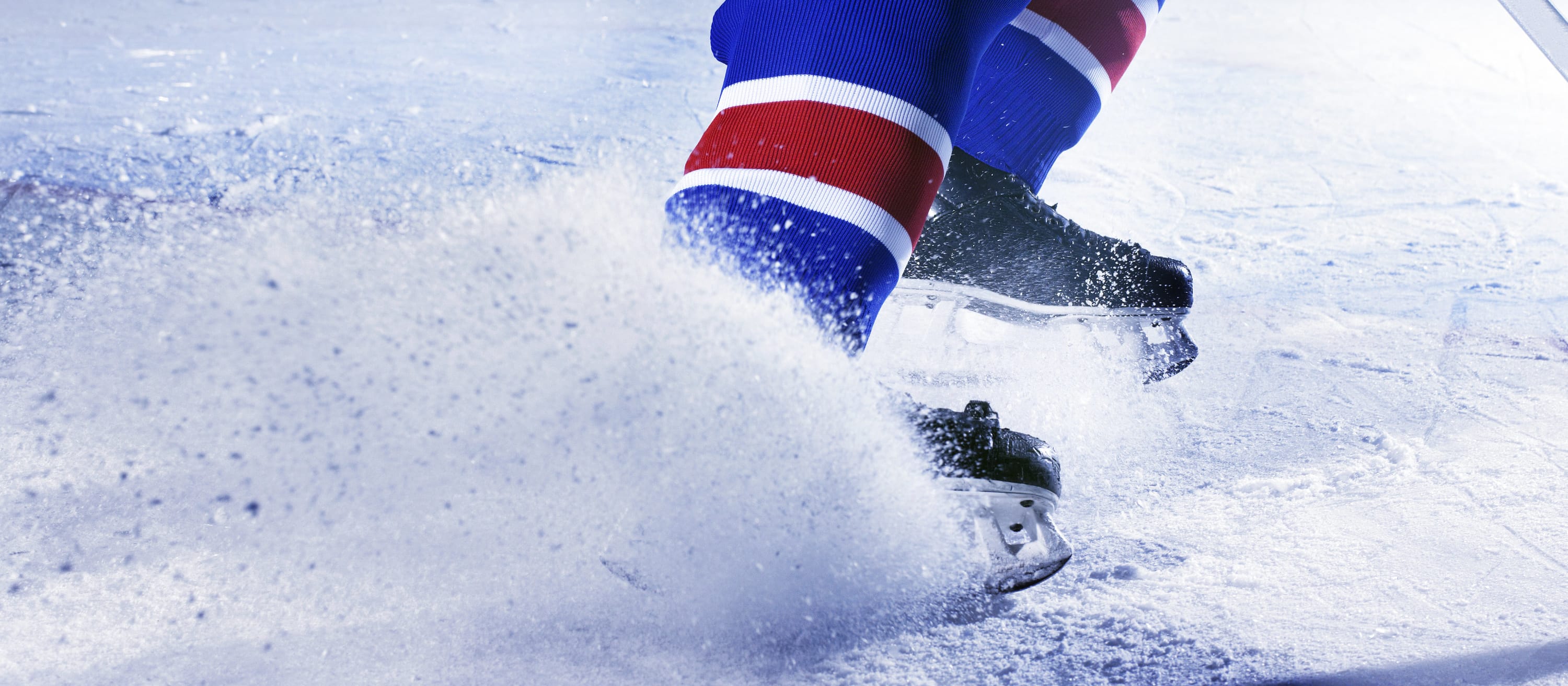Hits and suspensions have dominated much of the discussion early in the NHL season through various hockey media outlets and it seems that dissecting hits is a nightly segment for NHL's On the Fly. Unfortunately, dirty hits and other reprehensible on-ice incidents are the only occasions where the mainstream sports media lowers itself to discuss hockey, railing against the violence of the NHL in between the segments that essentially are police blotters for the NFL and NBA.
In these nascent weeks of the season, NHL Director of Player Safety Brendan Shanahan has shed much needed light on the process of how a player comes to be suspended, as his predecessor, Colin Campbell, disclosed slightly less than jurors in the O.J. Simpson trial. Shanahan's videos posted on NHL.com have given fans and players alike a more clear explanation of what is acceptable and what isn't, along with other criteria used in deciding a suspension length, such as past transgressions and the injury sustained. These details are usually presented in a tidy and informative power-point like fashion.
One of the more discussed suspensions of the last week was levied to Pittsburgh's Kris Letang for a check on Winnipeg's Alex Burmistrov this past Monday. Burmistrov was hit into the boards by the blue line in the defensive zone, turned as Letang was approaching him and braced for the hit. The Pittsburgh broadcasting team did not feel it was a check worthy of a suspension and there is some argument to be made.
Hits and suspensions have dominated much of the discussion early in the NHL season through various hockey media outlets and it seems that dissecting hits is a nightly segment for NHL's On the Fly. Unfortunately, dirty hits and other reprehensible on-ice incidents are the only occasions where the mainstream sports media lowers itself to discuss hockey, railing against the violence of the NHL in between the segments that essentially are police blotters for the NFL and NBA.
In these nascent weeks of the season, NHL Director of Player Safety Brendan Shanahan has shed much needed light on the process of how a player comes to be suspended, as his predecessor, Colin Campbell, disclosed slightly less than jurors in the O.J. Simpson trial. Shanahan's videos posted on NHL.com have given fans and players alike a more clear explanation of what is acceptable and what isn't, along with other criteria used in deciding a suspension length, such as past transgressions and the injury sustained. These details are usually presented in a tidy and informative power-point like fashion.
One of the more discussed suspensions of the last week was levied to Pittsburgh's Kris Letang for a check on Winnipeg's Alex Burmistrov this past Monday. Burmistrov was hit into the boards by the blue line in the defensive zone, turned as Letang was approaching him and braced for the hit. The Pittsburgh broadcasting team did not feel it was a check worthy of a suspension and there is some argument to be made. Letang could have done a better job avoiding Burmistrov, as Shanahan's explanation details that Letang still finished his check despite seeing the Jets' forward's numbers, also citing Letang's history as a reason for the suspension. The hit didn't appear to warrant a suspension and Letang was assessed a minor penalty, despite Burmistrov turning his back, but the loose puck the two were chasing was already deemed in Burmistrov's possession and Shanahan believed the onus was on Letang to minimize contact. Do players about to be checked have a responsibility to not put themselves in defenseless positions? There has to be some of the onus on Burmistrov in this instance.
The Week in Several Sentences
The Letang suspension massively affected owners in leagues with weekly lineups, as the star defender was only able to play in Monday's contest, sitting out the win over Montreal Thursday and Saturday's clash with New Jersey. Tampa Bay's Marc-Andre Bergeron registered four assists in his last two games as of Thursday's win over the Islanders while Zdeno Chara, Dustin Byfuglien and Duncan Keith have begun contributing to their team's scoring. It is worth noting Chara, as he had a goal and two assists to go with 21 penalty minutes in games against Toronto and Carolina. The Hurricanes' Joni Pitkanen and Vancouver's seemingly ageless Finn, Sami Salo, also saw their names scattered on box scores this week.
Florida exploded last Monday, potting seven goals against Tampa Bay including five on the power play in a 7-4 win. Sparking the attack from the back end was Brian Campbell with four assists, all coming on the power play. In a delicious touch of irony, Campbell still managed to finish the game a minus-1. Regardless of your past prejudices toward Campbell, Florida is deploying him freely, allowing Campbell room to rove and jump into the attack. Through Friday's games, Campbell sits with seven assists and a minus-4 rating. Six of Campbell's assists are on the power play, as he no longer has to defer to Duncan Keith and Brent Seabrook as he did in Chicago.
Ice, Ice Baby
This week's edition of Blue Line Buzz will examine ice time among defensemen and its affect on player production, (all statistics are through last Friday's games, Oct. 21). Several defenders log massive minutes while other players see a large portion of their ice time on the man-advantage. Defenders that eat up ice time may not always be in offensive situations, as they are counted on to shut down the opposition, contributing to the attack with nothing more than a crisp outlet pass to clear the defensive zone.
The league leaders in average power play ice time look different than the league's overall leaders amongst defensemen, save for two players. The following are defensemen currently averaging over five minutes of power play time per-game.
Dan Boyle, San Jose 6:51
Keith Yandle, Phoenix: 5:47
Brian Campell, Florida: 5:32
Joni Pitkanen, Carolina 5:15
Alex Edler, Vancouver 5:14
Tobias Enstrom, Winnipeg 5:12
John-Michael Liles, Toronto 5:08
Erik Karlsson, Ottawa 5:06
The league's top five among defensemen for average overall ice time has only two crossovers with the power-play leaders; Boyle and Campbell sitting third and fourth respectively. The Rangers' Dan Girardi leads the league, logging almost 29 minutes per-game (28:58) with Nashville's Ryan Suter in second at 27:52 and teammate Shea Weber in fifth at 26:10. Of the top 15 in the league, a handful don't see much power play time, such as the Rangers' Ryan McDonagh and Anaheim's Francois Beauchemin. Pittsburgh's Paul Martin and Boston's Dennis Seidenberg were probably later round picks in deeper leagues that see many minutes along with just under four power-play minutes per-game.
Yandle sees close to a quarter of his minutes-per-contest on the power play while Pitkanen also earns more than 20-percent of his ice time on the man-advantage. Pitkanen and Yandle appear to have one of the higher ratios of power-play time to ice time among the minute eaters, along with Boyle. The Columbus duo of Grant Clitsome and Fedor Tyutin both see over 4:00 of power-play time per game and New Jersey rookie Adam Larsson boasts an average of 4:51 on the power play. Budding Florida talent Dmitry Kulikov also is employed heavily on the man-advantage, with an average of 4:41 of his total 21:16 on the power play.
Fire Burn and Cauldron Bubble
San Jose's Dan Boyle has evolved much during his time in the NHL. Entering the league as a power-play specialist with the Florida Panthers, Boyle has fashioned himself into one of the league's elite defensemen, which translates into plenty of ice time alongside several highly talented teammates. As of Friday's win over New Jersey, Boyle sat third overall in average ice time with 27:48 per contest alongside an impressive 6:51 per-game on the power play. Boyle is the only player to see more than six minutes of power play time per contest in the NHL, and he's pushing the 7:00 mark.
Boyle is about as reliable as they come, but you probably already knew that. What is intriguing is how rounded of a player he has become and how he is still able to produce at a high offensive rate even with a litany of on-ice responsibilities. Boyle had three assists for the season as of Friday, but once San Jose's potentially lethal power play starts rolling, expect his numbers to fall in line with the 55 points he has averaged the last three seasons since arriving in the Bay Area.
New York, New York
Dan Girardi is highly important to the Rangers, even more so with Marc Staal shaking off post-concussion symptoms, as evidenced by Girardi's average ice time per-game of 28:58. While Girardi is a monster when it comes to hits, blocked shots and other ways to seemingly quantify defensive ability, he is essentially a less offensively skilled version of Brent Seabrook. Girardi's first point of the season came in Thursday's overtime win against Calgary and he sees just 1:59 of his 29 minutes per-game on the power play.
Despite his seemingly constant presence on the ice, Girardi is not always in offensive situations but he does possess the potential for 30-35 points, having notched 31 last season. Still 27-years old, Girardi's top professional points total came in the AHL with Hartford during the 2005-06 season, where he grabbed 39 points. He is a talented player and also a prime example of how more ice time doesn't necessarily translate into points, regardless of what he offers the Rangers. Girardi is worth a look in deeper leagues that reward categories such as hits and blocked shots.
Tailored Jacket
It's no secret that Columbus invested heavily in securing offense from their blue line with their gaudy contract offer to James Wisniewski, but the Jackets also feature several budding talents in Grant Clitsome and rookie David Savard. Clitsome and teammate Fedor Tyutin are both averaging over four minutes of power play time per game, but Savard is as well, having registered both of his season's two assists on the man-advantage. What makes Savard intriguing is his offensive upside and his averaging of 4:06 of power play time in five games, close to a quarter of his total 17:28 average. Savard posted 43 points in the AHL last season with Springfield and 77 his final year of juniors with Moncton of the Quebec League. Savard is in an ideal situation to be productive provided he can carve his own space along an apparently crowded Columbus back end. He sees a healthy percentage of minutes on the power play, but don't jump in too quickly; Savard was a healthy scratch in Friday's loss to Detroit and Wisniewski returns from suspension next week; be certain to check on Savard's status before moving forward.
New Era in New Jersey
This column has already discussed the potential impact rookie Adam Larsson could have during his NHL career. Larsson has drawn comparisons to both Scott Stevens and Nicklas Lidstrom but, through five games, he still has not registered a point. With young defensemen, the points will come, as Larsson seeks to secure his defensive zone, but it could simply be a matter of time before the talented Swede sees his name end up on the scoresheet. Larsson leads all New Jersey defenders in average ice time with 24:06, four minutes more than veteran Andy Greene at 20:02.
Larsson's demeanor was much talked about during New Jersey's training camp and his patience is on display while manning the point on New Jersey's occasionally inept power play, where he is averaging 4:51 per-game. Larsson shows the ability to walk the line and open up passing and shooting lanes, usually drawing defenders in before making a crisp pass to a teammate or feathering a saucer pass to Ilya Kovalchuk on the opposite point. When clearing his defensive zone, Larsson ignores forecheckers bearing down on him before making a strong outlet pass. Larsson has just eight shots on goal in five games, but he has been deferring to Kovalchuk on the power play and not every blast of Larsson's has landed on goal.
Keep an eye on Larsson, but his power-play time does not seem to be diminishing and he is hardly used on the penalty kill, averaging a mere 10 seconds per-contest of shorthanded ice time.
When examining potential additions to your roster, don't necessarily equate more ice time with more scoring opportunities for defensemen. Those who are power-play specialists like Marc-Andre Bergeron may be liabilities to your plus-minus, as well as their actual NHL team, but he and Pitkanen have shown the ability to cash in on their offensive opportunities.
Contact Dan Pennucci at [email protected] and follow him on Twitter @DVNucci42.
Hockey question of the week: Best and worst new uniforms for the 2011-12 season?
Best: Tampa's white away sweaters. Worst: Anaheim's webbed-foot black alternates.



























